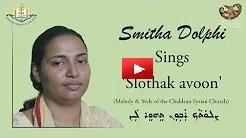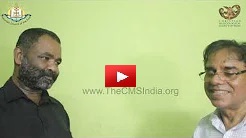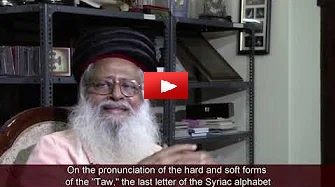Interviews and Performances - Video List
Aramaic Project - II
No. 10 to 1
Goto No. - | AP2-06 | AP2-05 | AP2-04 | AP2-03| AP2-02 | AP2-01| Aramaic Project Number | Description | Duration | Date and place of Recording | Video |
| AP 220/ AP2-06 | Processional song from Palm Sunday - Fr Antony Kaitharan Edta Qay le(h) Osana. Fr. Antony Kaitharan sings the processional song from Palm Sunday, Chaldean Syrian Church of the East, India. Fr. Antony Kaitharan, a talented singer of Syriac chants from the Chaldean Syrian Church of the East, India, has kindly given us a song for the Palm Sunday services. It is a welcome addition to the limited number of melodies from the Holy Week services in the East Syriac tradition in our Library. This and similar samples are primary source materials for researchers on Christian liturgies and music in India. These are also source texts for comparative studies of the vernacular versions of the respective liturgies. Familiarity with these chants can also promote greater understanding among different Syriac churches in India. We hope to enrich this section of our Library in the coming years. Joseph J Palackal, CMI |
5:11 |
 |
|
| AP 206 / AP2-05 | Anthem of the Mysteries. Fr. Anthony Kaitharan. Three melodies. Fr. Antony Kaitharan from the Chaldean Syrian Church of the East, India, sings three melodies of the 'Anthem of the Mysteries'. A special video. see more on Encyclopedia of Syriac chants http://thecmsindia.org/pagre-damashih... Note: Fr. Antony Kaitharan has been kind enough to give this recording in his voice. The chant is very special for many reasons. One, this is a single-strophe chant. Two, the chant has two different incipits. Three, it is sung twice with two different incipits. (Such chants are rare in the Syriac chant repertory). Four, the Syriac text instructs to sing the first incipit twice (Tni). This was probably a performance technique to draw attention from the congregation in the absence of a public address system in the olden days. It seems contemporary performance practice does not follow the printed text. This is the first time we hear different melodies of this chant for two different liturgical contexts. The third example is from the Chaldean Church in the Middle East. Fr. Kaitharan, who is studying in Rome, has the privilege of listening to these melodies from the students who came from the Middle East. The same text gets three different articulations in the three renderings, expanding the scope of comparative musicology. We are grateful to Fr. Kaitharan, and we hope to get more such recordings from him in the future to enrich our audio-video library. See more information at http://thecmsindia.org/pagre-damashih... Joseph J Palackal, CMI |
4:51 |
 |
|
| AP 205 / AP2-04 | ANN LIA & AGNA WILSON SING the Res Qala : Yada hūšāwē Res Qala ("Head Melody"), Yada Husawe. Ann Lia Wilson and Agna Wilson Muriyadan. From the liturgical tradition of the Chaldean Syrian Church of the East, India, with comments from Dr. Joseph J. Palackal. See the Syro Malabar version at Aramaic Project 11.9 Res Qala ("Head melody") is a compositional technique in the Syriac chant repertory. The meter and melody of the first strophe are applied to the rest of the stanzas in the chant. The underlying principle of Res Qala is similar to the concepts of the Indian Raga system as well as church modes in the Gregorian chant repertoire. Res Qala is apt for congregational singing. Since the melody is strophic, the worshippers can focus their attention on the semantics of the text. All the Syriac churches own chants in this category. In this video, we have a Res Qala, Yada Husawe, from the tradition of the Chaldea Syrian Church of the East, India. We are grateful to Wilson Muriyadan for sharing this video with us and granting permission to post it on our channel. We hope to get more Res Qale in the near future. Joseph J Palackal, CMI Keywords: #SyriacChants, #ResQala , #YadaHusawe Ann Lia Wilson, Agna Wilson, Muriyada,. Res Qala, Yada Husawe, Awa Hannana. |
5: 04 | Residence of Wilson Muriyadan at Trissur |
 |
| AP 204 / AP2-03 | Slothak Avoon. SMITHA DOLPHI. Chaldean Syrian Church of the East, India. This particular song is the common patrimony of the Syro Malabar Church and the Chaldean Syrian Church of the East, India. Surprisingly, the melody that Smitha sings is the same as the melody that we hear in the Syro Malabar Church. It means that the two churches shared melodies and musical practices before they parted ways and decided to establish their separate identities.. We have a few samples from the Syro Malabar Church on the editing table. Once they are ready, the recordings will be useful for comparative musicology as well as for music ecumenism. We are grateful to Wilson Muriyadan for introducing Smitha Dolphi to us. Keywords: Smitha Dolphi, Slothak Avoon,. Welcome song for the bishops, Chaldean Syrian Church of the East, India. Christian music India, Christianity Kerala Joseph J Palackal, CMINew York 10 July 2020 |
2:57 | 8 August 2017Residence of Wilson Muriyadan at Trissur |
 |
| AP 203 / AP2-02 |
Wilson Muriyadan : One of a Kind in the Syriac World Wilson Muriyadan : Self-appointed guardian of an intangible cultural heritage of Kerala. Note: Wilson Muriyadan, who is a member of the Chaldean Syrian Church of the East, India, is a person of particular interest to the Aramaic Project. Wilson is the owner of the most extensive private collection of books and manuscripts in Syriac in Kerala. Wilson’s collection includes many rare manuscripts and books that shed light on the history of the Syriac churches of the St. Thomas Christians in India. Wilson’s life story includes several subplots. First, Rekha, Wilson’s wife, is a member of the Syro Malabar Catholic Church. Rekha realized that her husband was “Syriac-crazy” only at the time of the wedding ceremony. Life went on smoothly, and later they baptized both their children in the Syriac ceremony. The children, who are growing up in a house full of Syriac books and manuscripts, have started learning the Syriac language. Second, how Wilson got the first set of books in his collection is part of a larger story connected to the Thrissur Provincial House of the Carmelites of Mary Immaculate. The librarian of the Provincial House at Patturiakkal decided to clean the shelves and sold the books and manuscripts as scrap paper to a street vendor. The street vendor, a Muslim, knew Arabic but did not recognize the Syriac script. Yet he thought those books could be valuable. He happened to meet Wilson and asked Wilson if he would be interested in purchasing the books. Wilson bargained and bought a set of rare books for the value of a mere five dollars. Third, Wilson intends to bequeath his extensive collection to his daughters. Ultimately, the fate of Wilson's home library depends on his two daughters. The older daughter, Ann Lia, already knows to read and write Syriac texts. While safeguarding his collection zealously like a mother-lion, Wilson is willing to share his knowledge and resources with researchers. I recently requested Wilson to help solve the controversy regarding the famous Syriac chant, Bar Maryam (“Son of Mary"). Some members of the Knanaya community objected to promoting this chant among the Syro Malabar Catholics on the website of the Aramaic Project. They put forward an unsubstantiated claim that this particular chant is exclusive to the Knanaya communities. I had already recorded several samples of the text and melody from different Syro Malabar Church musicians in the last decade. (see examples in Aramaic Project-51M , Aramaic Project-53). Yet, I lacked textual evidence. Fortunately, Fr. Placid Podipara, an expert in the history of Syriac Christianity in India, had referred to the earliest available source of the text of this chant (see Collected Works of Rev. Dr. Placid J. Podipara, C. M. I. (1899-1985). Vol. IV., edited by Dr. Thomas Kalayil, C. M. I., Sanjos Publications, Mannanam. 2007. Pp. 39-40). I had no way to find those resources. Wilson came to the rescue and located the sources and resolved the issue by providing textual evidence to my hypothesis that Bar Maryam is part of the common patrimony of the East-Syriac Christians. Christian Musicological Society of India is honored to introduce Wilson to the Syriac aficionados around the world. We are grateful to Rekha for participating in this interview. Wilson and his daughters are our resource persons for Part II of the Aramaic Project. Joseph J Palackal, CMINew York 18 January 2020 Keywords: Wilson Muriyadan, Syriac treasures of Kerala, Chaldean Syrian Church of the East, India. |
13:00 |
08 August 2017 Residence of Wilson Muriyadan at Trissur |
 |
|
AP 202 / AP2-01 |
Archbishop Mar Aprem Mookkan, Head of the Assyrian Church of the East Aramaic Project is entering into phase II with this informative conversation with Archbishop Mar Aprem Mookkan, the head of the Assyrian Church of the East. Among the eight churches of the St. Thomas Christians, the Assyrian Church of the East and the Syro Malabar Church share the same East-Syriac liturgy, but with a different mode of pronunciation and melodic repertoire. I was naturally curious to know the story behind those differences. Whatever the historical trajectories may be, the differences only add to the linguistic, musical and cultural complexities that are part of Kerala. This interview will be useful to future historians in all these different areas. We are immensely grateful to Mar Aprem for sparing time for this interview. We request the viewers of this video to help us continue this project so that we can create a historical witness to the current status of the Syriac language in Kerala in the 21st century, as well as to add resources to the ongoing discourse on Asian Christianity. To make a donation, please click on the donation button. Joseph J Palackal, CMINew York 10 January 2020 |
1:00:21 |
August 8, 2017 Metropolitan Palace of the Assriyan Church of the East, Trichur |
 |



